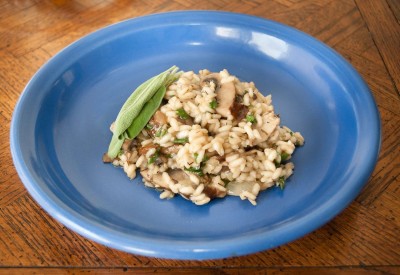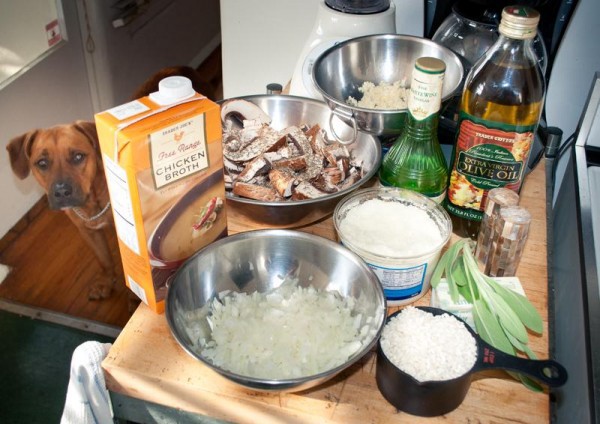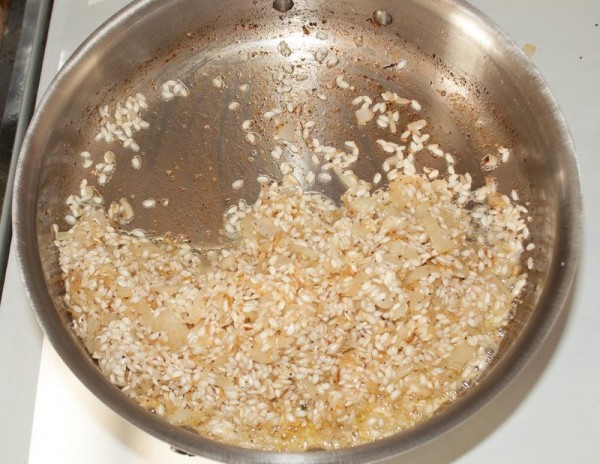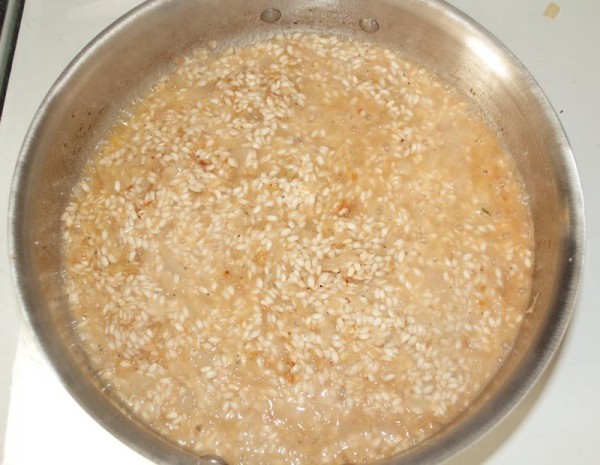How To Make Perfect Risotto
How To Make Perfect Risotto
by Eric Spiegelman

The summer after my junior year of college, I worked the prepared-foods counter at a restaurant on Newbury Street in Boston. It was called Stephanie’s, after its owner, who was an amazing chef. Stephanie made chicken breasts so tender you could almost drink them. Her julienned carrot salad sold out before noon every day. The chefs made gourmet mac and cheese in fifteen-pound batches, and there were always a couple pounds left over for the undergrad waitstaff to gratefully take home. But by far the most popular item on the menu was Stephanie’s risotto.
At some point early on that summer it occurred to me that I was surrounded by culinary experts and that I should take advantage of this. I also knew I probably only had time left in the summer to learn one thing well. So I picked Stephanie’s risotto. I picked that item out of all the other things offered at the restaurant because I was living in my first apartment at the time and I wanted to have sex in it. Not really knowing how to convince girls to have sex with me, I picked up a copy of GQ looking for advice, and there was an article that said if I could cook risotto, girls would have sex with me. Risotto, it said, is complicated, which makes it impressive, and it has many variations, so it’s really the only dish a single guy needs to know how to make.
Five days a week for ten weeks I watched the chefs at Stephanie’s make risotto during my lunch hour. Five nights a week for ten weeks I practiced cooking risotto in my apartment’s kitchen. It’s become a thing I order at restaurants solely to compare their risotto to mine, to figure out if they’re doing something I should copy. This is what I’ve learned.
FIRST OFF
Risotto is a simple dish that’s incredibly difficult to do well. It’s just rice with stuff in it. But it’s a different rice, special rice, extremely creamy rice that’s quite demanding to prepare.
INGREDIENTS

Arborio rice: This is sold just about everywhere they sell rice. Don’t get the rice that comes with a packet of herbs and different flavors. Get the plain Arborio. The Trader Joe’s Arborio that comes in a red box works just fine. There are a couple other rices that can be used for risotto, like Carnaroli, which is apparently known as “The King of Rice,” but don’t bother with these until you have some practice. That would be like someone grilling for the first time using a dry-aged rib eye — an atrocity punishable at The Hague.
Stock: Your basic risotto is made with chicken stock, which is the same thing as chicken broth, although there’s some debate about this. Just get the cans or boxes labeled “broth” and don’t worry about it. There are a lot of different stocks you can use — or you can make your own. If you make risotto for a vegan, you can use vegetable stock, but this is far more bland than chicken stock so you have to compensate for this with herbs or other sources of flavor. I once made my own stock from asparagus. It was okay. I’m very much obsessed with veal stock but haven’t tried it yet because I can’t find it anywhere and it takes a long time to prepare from scratch and also I don’t own a stock pot.
Stuff: What do you want to put in your risotto? My personal favorite risotto is mushroom risotto, and I usually pick two or three different varieties of mushroom. Always portabello, often shittake, and chanterelle if I feel like a badass with money to burn. (Chanterelles are $25 a pound! That’s crazy.) Seafood is also good, especially mollusks and crustaceans. Scallops are my other go-to, outside of mushrooms. Asparagus and other fresh vegetables also work well. White and red meats, however, are not fantastic, and are better prepared on their own and served on a bed of risotto or right next to it.
Whatever you buy, get like three or four handfuls of it, depending on how big your hands are, and treat your hands more like shovels than claws. Or, if the stuff isn’t loose, get two packages.
Onions: Use plain, boring, yellow onions. I’ve never had a good experience with white onions or red onions. Shallots sound fancy but their flavor is too subtle to compete with the other things you throw into the risotto.
Herbs: Your basic risotto calls for fresh, chopped parsley. I prefer rosemary, thyme, or tarragon. Fresh herbs are better, but if you only have dry herbs that’s fine too. The difference between fresh and dried herbs is when you throw them into the pan. Dried herbs are added early, before you add the stock. Fresh herbs are added at the very end, after the rice is fully cooked. This is a tip you can apply to all kinds of cooking, by the way. Dried herbs need time to get their flavor into the food; fresh herbs are more of an aromatic and should be added near the end. (I learned that in a cooking class once. I just saved you money.)
Butter, olive oil, garlic, salt, pepper: Have these things.
Cheese: You want a hard, dry cheese, grated or shaved. Basic risotto recipes call for parmesan, which works great. Asiago, also good. My favorite is romano. Get the freshly grated cheese that will go bad in a couple days that they sell in the fancy cheese section of the store. Get more than you need because you’ll be tempted to scoop some out and eat it with a spoon.
White wine vinegar: This is my secret little trick! I stole it from one of the chefs at Stephanie’s.
Truffle oil: Do yourself a favor. Buy a bottle of truffle oil. Black truffle or white truffle — it doesn’t matter. Truffle oil is one of the best things that the bounty of nature has in store for all who live in this world. It’s the most worthwhile expensive thing you can buy. Use it on everything.
Wine: For drinking while you cook.
HOW TO PREP
Cookware: You need a large saute pan, at least 11 inches in diameter. A saute pan is the frying pan with the perpendicular walls that are an inch or two high. You also need something to cook the stuff you’re going to put into the risotto. This will probably be a normal frying pan unless you cook something I haven’t thought of. Some recipes say you can cook the stuff in the same pan as the risotto but don’t ever, ever do this. It always comes out terrible. When you make mushroom risotto that way, the mushroom juice stains the entire dish an unappetizing brown. When you make scallop risotto this way, the scallop juice makes the whole dish smell like a pier. Just cook the stuff separately and everything will be fine.
Measuring: The only thing you need to measure is the rice. One cup is enough for two people to have seconds and still leave leftovers for the next day. Leftover cold risotto is really good. Two cups of rice is way too much, and you probably don’t have a pan big enough to cook all that. Do one cup plus a little extra, maybe one and half cups.
Chopping: For one cup of rice you need just over half an onion. Chop it coarsely with a knife. I made the mistake once of chopping the onion finely in a Cuisinart and it made the risotto taste terrible. The onion overwhelmed everything, including my guest, who passed out. Keep your onion’s surface area down and save the Cuisinart for the garlic, which takes forever to chop with a knife. Chop two, maybe three cloves of garlic. Your call there. Some people like a lot of garlic. Also, chop yo’ herbs.
Stock: Every risotto recipe out there tells you to measure out a certain amount of stock. Ignore this. Just have two cans or packages open and at the ready. You will probably not use all of it, but it’s better to have too much stock on hand than too little.
Stuff: It’s going to take at least a half hour to cook your risotto and most of the stuff you’ll want to add will take far less time. Have everything chopped, seasoned, whatever and in the pan ready to go on another burner so that you can just get the flame going and cook the stuff during the last ten minutes or so that you’re cooking the risotto. How much stuff you want depends on the kind of stuff you’re using. Mushrooms shrink when you cook them, so start with an overflowing mountain of them in a pan. For other kinds of stuff, a frying panful will do.
Everything else: Cut two pats of butter. Actually, that’s a lie. You’re supposed to use two pats but, really, you probably want to use like four or five. Have all containers and bottles open and within reach. You are not going the leave the stove for a while. Fill a wine glass to the top with wine, they way they serve you at a bar. This isn’t going in the risotto, by the way. It’s going in your belly.
AND HERE’S HOW YOU COOK THE RISOTTO
Pour some olive oil in the saute pan and throw in the butter. Put this over a medium-high flame until the butter melts. Dump in all the chopped onions. Stir it up. Fry the onions until they start to brown a little. Dump in the chopped garlic. Stir it up. Add some salt and pepper. It you’re using dried herbs, add those now. Cook all this until the onions are good and golden. Now dump in all of the Arborio rice. Turn the flame down to medium.
This is where the real work begins. Grab a wooden spoon and stir the Arborio rice. A lot. Stir the rice consistently and methodically. Get the grains of rice all coated with butter and oil and onions and garlic. Keep stirring. (Get used to it. For the next half hour of your life you will do nothing but stir rice. You will not leave the kitchen. You will not turn away from the stove. Your forearms will get sore but this will not stop you. Your only purpose in life will be to stir rice.)

Stir the rice like this for a couple minutes and then pick up the pan and give it a little shake so that the rice covers the pan evenly. Now pour in a bunch of chicken stock (or whatever stock you’re using). Pour in enough so that all the rice is just barely submerged. The contents of your saute pan should look like a bubbling primeval rice swamp. Now start stirring again.
Stirring the Arborio does two things. First, Arborio rice is high in starch, which makes risotto creamy, and the constant stirring coaxes the starch out of the rice. Second, the last thing you want is for the rice to stick to the pan and burn, and constantly moving it around ensures this does not happen.
I have developed a stirring technique over the years. I stir from the outside in, folding the edges of the rice into the middle all around the pan, and after I’ve done a full circle around the pan I push all the rice from the center out toward the periphery. Then I shake the pan to even the rice out, and do the whole thing again. I have no idea if this is how you’re supposed to do it, or if there’s even a way you’re supposed to do it, but it seems to work and keeps the muscles in my arm from getting too fatigued.

As the rice absorbs the chicken stock, add more chicken stock. Just a little each time. You don’t want the rice to get too dry and you don’t want to drown it either. Be conservative. Pour then stir. Pour then stir. Blank your mind and enter a zen state of stirring awareness. Drink more wine.
The hard part about risotto is knowing when it’s done. After you’ve been pouring and stirring and drinking for twenty minutes, it’s time to start keeping an eye on the doneness of the rice. Risotto is served al dente, which is Italian for “to the tooth,” which is an unhelpful translation. Al dente refers to a certain degree of firmness and there are two ways to determine whether your rice is al dente yet: with a fork or with your teeth.
Here’s the fork method. Take out a single grain of rice and put it on a cutting board and cut it in half. The cross-section of the grain should look like a sliced open Good & Plenty. The outer part will be soft and relatively translucent, and the core will be hard and white. The hard white part is the uncooked part of the rice. Risotto is al dente the moment that white part becomes translucent. Anything longer is too long.
Using your teeth is actually better. It’s faster and you can do it without taking your attention off the pan, which you may have figured out by now is crucial to the risotto-making process. Scoop out some rice and chew it. The rice should give but not crunch or squish. This is the mouthfeel of al dente. If the rice crunches, you need to cook it longer (with more chicken stock and stirring). If it squishes you’ve overcooked it.
Risotto is also not supposed to be clumpy. It should spread slowly on its own like really wet mud when you put it on a plate. This I learned from “Top Chef.” My risotto was clumpy for twelve years and I didn’t know this was a problem until I saw Tom Colicchio yell at contestants because the way their risotto moved on his plate displeased him. This caused me some measure of shame (even though my clumpy risotto still tastes great.) I am presently still trying to master the secret to non-clumpy risotto, and what I’ve figured out so far is that if the rice dries out too much — i.e., if you let the chicken stock absorb without adding more — clumpy happens. I think you need to keep the rice wet enough so that it keeps spreading on its own in the pan, but not so wet that it looks like the rice swamp when you first pour in the stock. Getting the timing right is tricky. If you get worried that your rice is al dente but there’s still too much chicken stock left in the pan, turn the heat way up and stir like crazy. This gets the excess stock to burn off. Don’t rely on this, however. It’s only to be used in an emergency.
Now, if you feel comfortable taking your risotto up a notch, then just a moment before the rice is al dente, add a small dash of white wine vinegar, like maybe a half teaspoon, and stir it in. A little bit goes a long way. Too much and your rice will taste like laundry. White wine vinegar gives the risotto a bit of a lighter taste. I have no idea why.
When the rice is finally cooked, turn off the heat and just dump in all the stuff (that you should have already cooked in a separate pan on the side), the mushrooms or scallops or whatever. Make sure you drain out the excess liquid from the stuff before you mix it into the risotto. Add your chopped fresh herbs. Add salt and pepper. “Season to taste” as they say. Stir all this into the rice, and then sprinkle your cheese into a thin layer on top. I like to stir a bit of cheese in and then add more on top, but then I generally like things cheesy.
Cover the pan of risotto until its ready to be served. Transfer it to a gigantic bowl and bring it to the table. And then, just before you eat it, drizzle some truffle oil on top. Don’t do this in the kitchen; do it at the table in front of people. It’s a subtle way of telling them, “not only did I just make you risotto, but now I’m pouring truffle oil on it so how about that.”
Also in Half Baked: Perfect Tarte Tatin In 10 Easy Steps
Eric Spiegelman is a web producer in Los Angeles.
